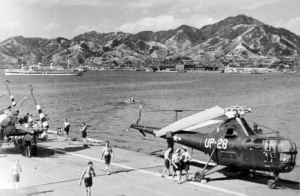The Westland Dragonfly H.R.3 helicopters were loaned from the United States Navy to the RAN for use onboard the aircraft carrier HMAS Sydney during her deployment to the Korean War during 5 October 1951 – 25 January 1952. The helicopters were flown by US Navy personnel and performed air-sea rescue and general transport/communications duties and were returned to the US Navy when Sydney departed Korean waters.
The need for helicopters for air-sea rescue operations was quickly re-inforced on 26 October 1951 when a Firefly, flown by Sub-Lieutenant Neil MacMillan, RAN and Observer 1st Class Phillip Hancox, was shot down after an attack on a railway tunnel north-east of Chaeryong, North Korea.
RAAF Meteor aircraft and RAN Sea Furies provide cover while a Dragonfly helicopter piloted by US Navy Chief Aviation Machinist Mate Arlene ’Dick ’Babitt, with 22 year old Aviation Machinist Mate 3rd Class Callis Gooding as aircrewman, flew the nearly 180 kilometres from Sydney to the crash site. MacMillan and Hancox had abandoned their crashed aircraft and were now sheltering in a ditch awaiting rescue. Enemy troops began to arrive on the scene and started firing at the two Australians. The situation was now indeed desperate for the downed aircrew, however, moments later Babitt’s helicopter arrived on the scene and landed within six metres of the two men. MacMillan and Hancox ran to get on board while Gooding opened fire on the enemy soldiers with an Owen gun; which he had been given only a few minutes before launch and provided with rudimentry instructions on its use.
The helicopter then lifted off and headed for Kimpo Airfield, Seoul arriving in darkness and upon landing the Dragonfly was unable to taxi due to having run out of fuel. Babitt and Gooding were both awarded the US Navy Cross for their heroism and Chief Petty Officer Babitt was also awarded the Commonwealth Distinguished Service Medal (DSM) for his skill and bravery.
The use of these two helicopters on board Sydney further reinforced the RAN’s decision to acquire its own helicopters and led to the purchase of the Bristol Sycamore helicopters.

